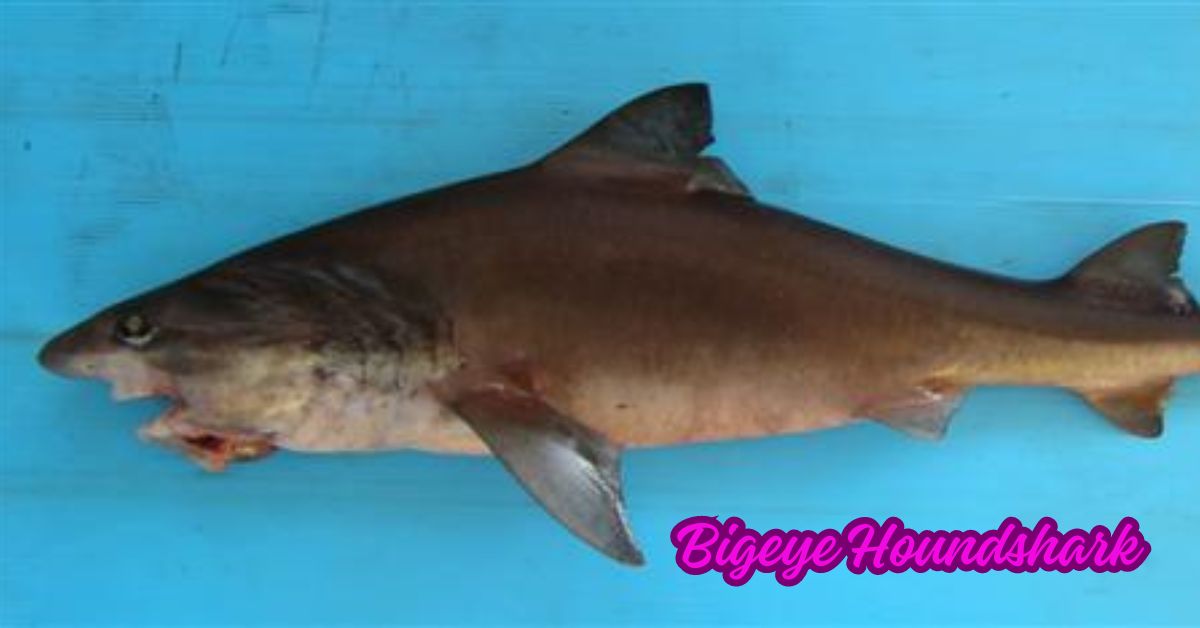The bigeye houndshark (Iago omanensis) is a species of houndshark belonging to the family Triakidae. This deep-water shark is found in the western Indian Ocean, inhabiting the continental shelves and slopes at depths ranging from 110 to 2,200 meters.
Physical Characteristics
The bigeye houndshark is characterized by its elongated body and larger eyes compared to other houndsharks. Males are typically smaller than females, with females reaching maturity at around 40 cm in total length and males at 31-32 cm. The maximum recorded length for this species is approximately 58 cm.
Habitat and Distribution
The bigeye houndshark is found in areas with consistent water temperatures ranging from 16 to 25°C, such as the seafloor consisting of mud, sand, and rocks. Its native range includes the Red Sea, Gulf of Oman, southwest India, and the Bay of Bengal.
Feeding Habits
As a predator, the bigeye houndshark primarily feeds on bony fishes and other bottom-dwelling creatures like octopus and squid. Studies conducted in the Gulf of Oman have revealed that teleosts make up the majority of its diet (89.94%), followed by crustaceans (9.21%), mollusks (0.83%), and chordates (0.01%).
Reproduction
Bigeye houndsharks are ovoviviparous, meaning they give birth to live young that have developed inside the mother’s body. Females typically give birth to 2 to 10 pups per litter at two-year intervals. The gestation period ranges from 10 to 12 months, depending on location and water type, with newborns measuring approximately 16 cm in length.
Conservation Status
Currently, there is no evidence to suggest that the bigeye houndshark is in decline. The International Union for Conservation of Nature (IUCN) has not listed any conservation concerns for this species.
Parasites
Studies have revealed that the bigeye houndshark hosts various parasites, including diphyllidean cestodes. A new species of Coronocestus, C. ehsanentezarii, has been described from I. omanensis in the Gulf of Oman. Additionally, a new locality record for C. diamanti has been reported from the same host species in the same region.
Taxonomy and Evolution
The bigeye houndshark belongs to the family Triakidae, which includes 40 species of small to medium-sized sharks. The genus Iago, to which the bigeye houndshark belongs, consists of three species: I. omanensis, I. garricki, and I. labordei.
Ecological Importance
As a top predator in its environment, the bigeye houndshark plays a crucial role in maintaining the balance of the deep-sea ecosystem. It helps to regulate the populations of its prey species, which include various bony fishes, crustaceans, and mollusks.
Threats and Conservation Efforts
While the bigeye houndshark is not currently considered threatened, it may face potential threats from deep-sea fishing activities and habitat degradation. Monitoring the population trends and implementing sustainable fishing practices are essential to ensure the long-term survival of this species.
Conclusion
The bigeye houndshark is a fascinating deep-sea predator that has adapted to the unique challenges of its environment. Despite its elusive nature, this species plays a vital role in the ecosystem of the western Indian Ocean. As we continue to explore and understand the deep sea, it is crucial to protect species like the bigeye houndshark and their habitats for future generations.
FAQs
- What is the maximum depth at which the bigeye hound-shark can be found?
The bigeye hound-shark can be found at depths ranging from 110 to 2,200 meters. - How does the bigeye hound–shark reproduce?
The bigeye hound-shark is ovoviviparous, meaning the females give birth to live young that have developed inside their bodies. Females typically give birth to 2 to 10 pups per litter at two-year intervals. - What is the conservation status of the bigeye hound–shark?
The International Union for Conservation of Nature (IUCN) has not listed any conservation concerns for the bigeye hound-shark, and there is currently no evidence to suggest that the species is in decline. - What are the main threats to the bigeye hound-shark?
Potential threats to the bigeye hound-shark include deep-sea fishing activities and habitat degradation. However, more research is needed to fully understand the impact of these threats on the species. - How can we protect the bigeye hound–shark and its habitat?
Monitoring population trends, implementing sustainable fishing practices, and protecting the deep-sea habitats of the bigeye hound-shark are essential for its long-term survival. Continued research and conservation efforts will help ensure the protection of this fascinating deep-sea predator.










